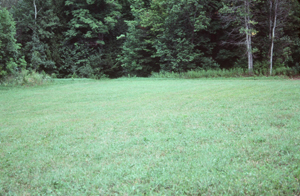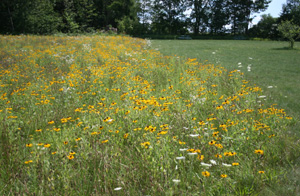My Cart: 0 item(s)
Post-seeding Management
|
After you have seeded your meadow, applied a thin layer of straw mulch and watered (if seeds were sown in the spring), it's time to wait for germination to begin. If you planted in the fall, your seeds will sit dormant in the soil until the ideal conditions of spring to begin germinating. If you planted in the spring, it is likely that only some species will germinate as most wildflowers need cold, moist stratification to germinate. In other words, the seeds need to experience the cool temperatures and the freeze/thaw action of winter to soften their shells and facilitate germination. Don’t worry your seeds will lay dormant until the time is right and in the meantime, the grasses and the annual rye nurse crop will keep the soil in place and help keep weed seeds from germinating. Once germination has occurred and things start to "green up", you will need to faithfully follow a two year management schedule to ensure weeds are kept at bay and your wildflowers and perennial grasses have the best chance for survival. First Year Management
Spring and Summer Management This may sound crazy, but mowing your meadow in the first year is the most important step after seeding. In their first year of life wildflowers and native grasses put more energy into root development than top growth, this is actually a good thing as your meadow slowly takes control of the land. And, being perennials, they do not produce flowers in their first year at all. The fact is that even with as much work as you have done to carefully prepare your land for your wildflower seeding, it is impossible to get rid of every weed seed! However, most weeds are quick growing annuals and they can be controlled by keeping the site regularly mowed to a height of approximately 6 inches (15cm) in this first year of growth. This mowing prevents these weeds from making seeds so they can't return in the future and mowing allows the sun's light to reach down to the seedlings; providing them with energy. You won't harm your wildflowers by this mowing; in fact, you'll be encouraging them to develop strong root systems as the seedlings send energy to the roots rather than to the stems and leaves. Another reason for this mowing is that the nurse crop of annual rye grass that we include with our seed mixes is also an annual and thus it too will try to make seeds. The purpose of this nurse crop of annual rye grass is to help hold soil moisture as well as to provide a bit of shade to the seedlings during the hottest times of summer. The nurse crop grows rapidly without competing with the wildflowers and grasses and occupies the "ecological niche" that would otherwise be taken by annual weeds, thus reducing weed growth. The annual rye is not needed in the second year of your meadow and you should not let it go to seed. Be sure to keep the weeds in check! For large meadows a tractor drawn flail-type mower works best, as it chops up the weeds so they can dry out rapidly. Rotary mowers and sickle bar mowers are not recommended as they do not chop up the weeds and this can smother your seedlings. For smaller meadows of an acre or less, string trimmers or "Weed-Eaters" are excellent for cutting back weeds. These devices gently lay the cut material down on top of the cut stems where it will dry out rapidly and not smother your seedlings. Riding lawn mowers also work well. Whenever weeds or any vegetation reach a height of 12 inches (30 cm), it's time to mow your meadow. Do not allow the weeds to get taller than this before cutting. Tall weeds will shade out your seedlings and the large quantities of weedy material that will eventually have to be cut back can smother the small seedlings. On average, you will be mowing your meadow once a month until the fall but keep in mind that greater than average rainfalls will encourage rapid weed growth and you may need to mow more often. Tip: Avoid mowing or walking over your meadow area when the soil is wet. Wet soil is more easily compacted, reducing air pockets (water pockets when it rains), making it difficult for young roots to push through. You also have the potential to create ruts where water will pool and not drain properly if you drive in your meadow. Fall Management If you experience cold, snowy winter conditions, at the end of the first season, do not mow down the year's growth. Leave it to help protect the young plants over the winter. The plant litter and the snow that it catches insulates the soil from rapid changes in soil temperatures, which can cause plant losses due to frost heaving. If your winters are relatively warm (i.e. you don’t get snow), you may stop mowing once the threat of weeds going to seed has ended. Pulling Weeds Despite the temptation, pulling weeds in a first year wildflower meadow seeding is not recommended. Wildflower seedlings are very small the first year and can be easily pulled up right along with the weeds! If you can identify weeds when they are still young and small, it is safe to carefully pull them, making sure you do not disturb adjacent wildflower or native grass seedlings. If you must pull a large weed hold your feet closely together on either side of the stem at ground level and pull straight up. This will hold the surrounding soil and any nearby wildflower seedlings in place as you extract the weed. Firm any disturbed soil and seedlings by tamping with your feet. If the soil is dry, watering after pulling weeds is beneficial for seedlings that may have been dislodged during the process. Beware that pulling weeds creates soil disturbance, which exposes new weed seeds and encourages their germination. If you wish to avoid this, or have large well-established weeds that cannot be easily pulled, you can cut weeds off at the base using pruning shears. Remove any seed bearing weeds from the site immediately after cutting. Second Year Management
Spring Management In mid-spring of the second year the planting should be mowed as close to the ground as possible and the cuttings raked off. At this stage, the plants are still small and have not yet gained full control of the soil environment. Mowing in mid-spring helps to set back non-native cool season weeds and grasses such as Quackgrass, Bluegrass, and Bromegrass. Timing is very important when mowing your meadow. The best time to mow most meadows is when the buds of the Sugar Maple tree (Acer saccharum) begin to break open in spring. This usually will occur sometime between April 1 and May 15, depending on your location and the weather in any given year. This is also about the time we are mowing our lawns for the first time. Mowing in mid-spring facilitates germination of dormant seed and enhances the growth of wildflowers without potentially increasing weeds. This second year of growth can be a bit of a judgement call, you will need to keep an eye on your meadow’s growth. If you see that weeds remain a problem, you will have to be mow them in late spring or early summer and possibly again in mid summer. If you decide that your meadow is not weedy, then you can leave it alone and let the plants grow. You may even see some flower blooms! Please note that biennial weeds such as Burdock, Thistles, Queen Anne's Lace and Wild Parsnip can be very competitive in the second year. Mowing them back to about one foot in height when they are in full bloom will kill them or set them back severely, with minimal damage to your plants. If you decide that your meadow is not weedy, then you can leave it alone and let the plants grow (you may even see some flower blooms!). A biennial weed of particular concern is Sweet Clover (Melilotus spp.). This must be controlled because the seeds of Sweet Clover can become a long-term management problem if not handled at the outset. Mowing in mid-summer of the second year when in full bloom will usually kill Sweet Clover plants and prevent them from making seed to re-infest your planting. If it reappears in the third year, it will likely be on a limited basis and can be hand-pulled. Do not let sweet clover make seeds, as it can be a most pernicious weed.
In the fall of your meadow’s second year, it is likely that you will not have to do anything. Growth should be left in place to protect smaller plants from winter frosts and snowfalls. Your meadow may also be home to birds, small mammals, and other wildlife so disturbing it now would mean disturbing their new home. |




